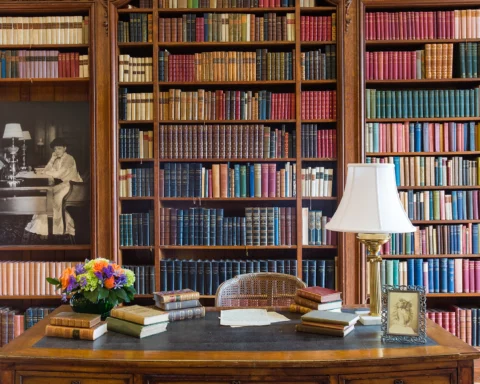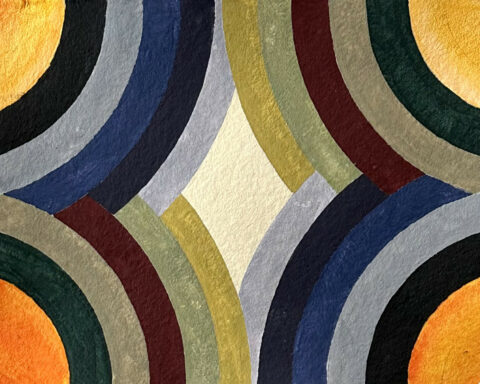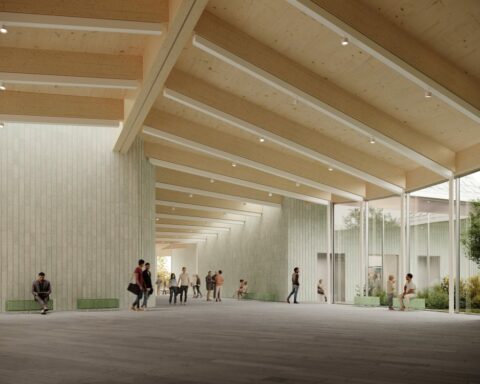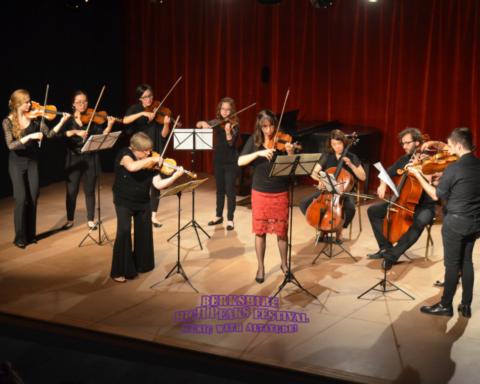Xylor Jane: Counterclockwise & Terry Winters: Facts & Fiction
“I saw it in New York,” or “I saw it in the city” is an often-heard response when an exhibit of well established artists come to the mountains and valleys of western Massachusetts. It happens all the time at MASS MoCA. My response generally is, “Well, did you see it in a gallery the size of a football field? Could you look down on it from above?” One such show, slightly to the east of us, is now on view at the University of Massachusetts Amherst Fine Arts Center, which houses the University Museum of Contemporary Art.
If you have never been there before, the building itself is a tribute to brutalist architecture while honoring the goal of educating middle and working class residents of Massachusetts. This massive, poured concrete edifice was specifically designed as a contemporary building in the 1960s, by Kevin Roche and John Dinkeloot, who’s mission was to create a structure that was not a facsimile of exclusive New England colleges, but a tangible notice that all students deserved an opportunity to attain a world-class education. With that thought in mind two extraordinary exhibits have opened this month in the University Museum, Terry Winters: Facts and Fictions and Xylor Jane: Counterclockwise.
Both artists, Winters and Jane, share a common starting point when making work. They utilize grids, technological networks, mathematics and science. As you descend into the large vault-like cement gallery, it becomes clear their end results are very different, but equally mesmerizing.
Xylor Jane, Counterclockwise
In the first space to your left, local Greenfield resident, Xylor Jane’s paintings hypnotically kidnap you and take you to a world of magical numerology, gridded Arabic numerals, tetradic primes, and Fibonacci sequences. At first, maybe you see the numbers or maybe you don’t. Start staring. Most viewers of Counterclockwise might not have an inkling of the mathematical concepts employed in creating this work, but the quivering, almost animated art pieces, act as magnets on the viewers, causing them to step close and then back, and repeat.
![Xylor Jane, Squared Up; ink & oil on panel; [Source: CANADA Gallery, New York]](https://i1.wp.com/www.greylockglass.com/wp-content/uploads/2019/02/xj2016-005_xylor_squared_up_3x3.6.jpg?fit=831%2C1024&ssl=1)
Composed of miniscule marks in a seven-hue system of explosive color, Jane’s work is often compared to pointillists such as George Seurat and mid-century artists, Agnes Martin and Alfred Jensen, who also used mathematical systems and grids. This resemblance is obvious, and though she is relying on ancient principles, her work has the sense of something much more contemporary, much more akin to LED installations by Jenny Holzer and Tatuso Miyajima (who also is inspired by the spirituality of numerology). In the end, Jane’s work is unique and is both ancient and contemporary at the same time, not an easy accomplishment. She says her work is about love—once you see the show, there is no question about it.
Terry Winters, Facts & Fiction
Terry Winters. Most of time, that is all you need to say. Since the early 1980s, Winters has been a major influence not only as a success in the gallery / collector / museum world, but also as a significant inspiration to fledgling artists. By relying on biological illustrations, grids and other patterns both mathematical and scientific, he found a method of beginning a drawing based on structure rather than emotional inspiration or classic western methods such as perspective. His interest in art materials led him to experiment and create his own mediums. Due to this duality — structure and touch — his work possesses a rich sensuality not usually associated with art created from systems.
Facts and Fictions, now on view at the University Museum of Contemporary Art, originated at the Drawing Center in New York City and was curated by Claire Gilman, Chief Curator. This is not your typical retrospective. The exhibit, including 78 drawings, spanning 40 years, highlight the hand, intelligence, and innovative nature of Winters, rather than a chronological nod to a body of work. The emphasis of the exhibition is on the structure and relationship of the work and the beauty of Winters’ hand.
As you enter a large cave like gallery, four large freestanding cases occupy the center of the space. Inside, suites of small drawings shed light on his process of drawing over the years. The concrete walls are lined with larger pieces in the range of 44 ¼ by 30 ½. Ironically the more biomorphic drawings become more enlivened by the solidity of the wall. Winters uses crayon, charcoal, graphite, gouache, watercolor, ink, and colored pencil. These are smeared, erased, rubbed and repeated until they are finished. To Winters, drawing is an end to itself and is on equal footing with other mediums such as painting and printmaking. This is not only a ground breaking drawing exhibit but it is also in a perfect place to see the work, an educational institution.

![Terry Winters, Untitled (2), 1999; gouache on paper, 44 1/4 X 30 1/2 inches; private collection [Source: Matthew Marks Gallery]](https://www.greylockglass.com/wp-content/uploads/2019/02/48c88952a8ec7dfbd7041827a6e46bee86e8c132.jpg)
















Trenchant insights, enticing descriptions. Great promotion for the exhibit. I like what you say about UMass architecture!